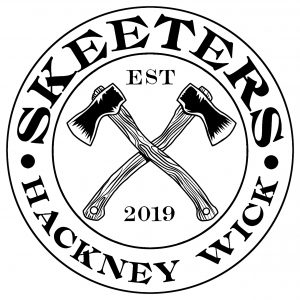What Makes an Axe? There are a surprising number of constituent parts which make up an axe, and this handy guide will talk you through them.
The Blade or the Bit
- Toe- The upper corner of the Axe head’s bit is the toe. This is the part of the axe you are aiming to hit with. By sinking the axe with this point, the maximum force is put into the smallest area. This gives the best chance of sticking.
- Cutting Edge- This term addresses specifically the sharp of the blade and is largely interchangeable with the blade or bit.
- Bevel- This is the ground away sloped portion of the blade/ The angle of the bevel varies and this affects its striking impact. A splitting axe for example will have a more obtuse angle than a throwing blade which will typically be very acute.
- Heel- This is the bottom of the blade. If the heel is sticking you under rotated your throw.
- Beard- The sloping section that recedes away from the blade is the beard, not all axes have these. The stereotypical ‘Viking axe’ or ‘Dane axe’ is known for its beard.
The Head
- Eye- The eye of the axe is the hole at the top of the axe where the handle is wedged and protrudes.
- Cheek- The side of an axe head is known as the cheek, following the anatomical naming pattern.
- Poll- This is the flat back face of the axe. In some designs this is replaced with a hammer or spike, but for most conventional purposes it is flat.
- Lug- Not present on all axes, the lug is a small extension of the head down the handle. It provides additional security for the head, and in poleaxes develops into Langets.
The Handle
- Neck- This is the portion of the axe directly below the head. While the shoulder is part of the neck, the neck refers to the entirety of this sections circumference.
- Shoulder- The part of the handle just below the head at the back. This element is typically wider than the rest of the handle as it sits tightest to the eye.
- Belly- The mid section of the axe handle which curves on some axes, is the belly. Throwers hands typically sit on or just below the belly, as such in many designs it curves to comfortably contour the hands grip.
- Throat- Just below the belly is the throat, this is the most typical grip point for throwers, and provides a slight tapering comparative to the rest of the handle.
- Grip- The throat’s circumference can be referred to as the grip.
- Swell- The swell, or knob, is featured on some axes and typically are larger in scale with the size of the axe. This swell stops the hand from slipping off the handle too easily. As such they are not always preferred by throwers.



No responses yet